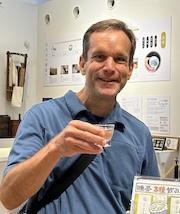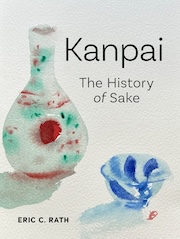LAWRENCE — In 2024, the Japanese government successfully petitioned UNESCO to declare the venerable process of sake brewing an “intangible cultural heritage.”
But the history of sake itself is largely unknown to most people outside of Japan.
“Like sushi, it’s one of the touchstones of Japanese cuisine,” said Eric Rath, professor of history at the University of Kansas.
“You can’t not run into sake if you look at Japanese food culture, if you look at ritual, if you look at daily life. It’s there in many different forms.”
 Eric Rath
Eric Rath
Rath’s new book, titled “Kanpai: The History of Sake,” which is the first such history in English, explores sake’s evolution from homebrew to flavored varieties while tracing its cultural significance and global rise. The work is published by Reaktion Books.
“Sake is made with water, rice and a mold called koji. There’s this notion that because these are very simple ingredients, this process is something timeless that’s been unchanged for millennia. But when you look at the history, you see how the recipe has changed, and it continues to evolve,” Rath said.
The beverage’s place in Japanese society has also changed. Rath notes sake only occupies 5% of the country’s alcohol market today. That’s somewhat unexpected, given that the word “sake” can mean alcoholic beverage, synonymous with booze. Statistically, however, four times more beer is consumed in Japan.
Having researched Japanese food culture for the last 25 years, Rath was surprised to learn no one had written an academic history of sake in English.
“That’s a huge gap,” he said.
“You get a lot of individuals who write about sake appreciation, what brand to buy and how sake is made. There are some great sake educators out there, but there’s no sake history, and so that results in misconceptions. A lot of people get left out of the story. There’s a whole side of home brewing I talk about in my book. Also, women played a great role in sake brewing in the medieval period, and sometimes they get omitted or their contributions get downplayed.”

A misconception also lingers regarding what sake fundamentally is.
“It’s not a rice wine. It’s made completely differently and brewed more like a beer,” Rath said.
“I want people to know its place in Japanese culture. I want them to know that the recipe for it has changed, and my book includes recipes for sake. I did a little home brewing, too, along the way, and that was fun. I want to show what the government’s done in the last century to change sake, both for the good and for the bad.”
For instance, the Japanese government banned sake home brewing in 1899. It later reinforced the ban to increase tax revenue from commercial sales. But in the 1970s, home brewing became a touchstone for peace activists who were opposed to the building of an airport at Narita (in the Greater Tokyo area).
“Home brewing turned into a rallying point for them, arguing it was protected by the Japanese constitution. They had the ‘freedom to brew.’ But ultimately the government said, ‘No, you can’t brew at home.’ Yet people still do,” Rath said.
The book’s title, “Kanpai,” refers to the traditional toast uttered when drinking in a group setting. This literally translates to “dry cup.”
“It’s an adaptation of the British word ‘cheers.’ The story is that Japanese naval officers wanted some kind of phrase to toast the emperor, counterpart to what the British were doing. So they came up with kanpai,” he said.
He said Americans have increasingly embraced sake.
“It’s really growing in the United States,” he said. “We have around 20 craft breweries in North America. A lot of these places have opened in the last five years, and they’re doing some incredible things. There are breweries in Tennessee, Arkansas, California. Brooklyn alone has three sake breweries.”
A 26-year veteran of KU, Rath teaches a course on the history of sushi. His previous book, “Oishii: The History of Sushi,” (Reaktion Books/University of Chicago Press, 2021) offers the first comprehensive chronicle of sushi written in English. He is also a member of the editorial team for Gastronomica: The Journal for Food Studies.
Personally, Rath enjoys many variations of sake flavors and types. But when in Japan, “I like to drink something local,” he said.
“The amazing thing about sake is you can try it at different temperatures. With the same bottle, you can have it chilled or room temperature or heated up a little bit. The flavor profile will change so much. It’s the only alcoholic beverage I know of that you can do that with.”


AloJapan.com